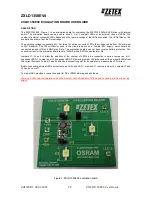
TPS2149 Setup
3-2
3.1
TPS2149 Setup
The USB keyboard/hub EVM is designed to allow evaluation of the TPS2149
device. Test points and 0-
Ω
resistors are provided to simplify the evaluation
process (see Section 3.5). The EVM comes in a default configuration that
requires no additional components, other than the required hardware and
software identified in Section 1.1 of this user’s guide. For a complete
description of the TPS2149 device, consult the TPS2149 data sheet (literature
number SLVS401).
3.2
Interfaces and USB Ports
The EVM uses a standard Type-B connector for the upstream port and two
single Type A connectors for the downstream ports. Power to the downstream
ports is provided throught the TPS2149.
Two edge connectors, J3 and J4, connect to the TUSB2136 general-purpose
I/O lines. Out of 32 general-purpose I/O lines, 26 are brought out to the J3 and
J4 connectors. The remaining 6 I/O lines are used onboard to control the LEDs
(see Section 3.4).
3.3
Power Supplies
The USB keyboard/hub EVM requires no external power supply for operation.
The EVM receives power via the USB cable. The TPS2149 low-dropout
regulator is used to generate the required 3.3-V supply from the USB 5-V
supply. The power indicator LED (D1) will turn on whenever power is available
to the EVM (see Table 3–1).
3.4
Light Emitting Diodes (LEDs)
Several onboard LEDs are provided on the EVM for quick and easy evaluation.
A set of six green LEDs (D2 – D7), connected to P3.0 through P3.5 of the
TUSB2136, may be used for general purposes in any code that is written for
the TUSB2136 (see Table 3–1). By default, the factory code provides the EVM
with the use of only three of the LEDs as keyboard status indicators for Scroll
Lock (D2), Caps Lock (D3), and Num Lock (D4). The other three are not used.
Table 3–1. LED Description
LED
Description
D2–D7
Green LED ON indicates corresponding GPIO pin is low (when D1 is ON).
Green LED OFF indicates corresponding GPIO pin is high (when D1 is ON).
D1
Red LED ON indicates that the EVM is powered on and not suspended.
Red LED OFF indicates that the EVM is powered off or suspended.
Summary of Contents for TPS2149
Page 1: ...September 2001 Mixed Signal Products User s Guide SLVU050...
Page 6: ...vi...
Page 8: ...viii...
Page 12: ...2 2...
Page 16: ...3 4...
Page 19: ...5 1 EVM Layout EVM Layout Figure 5 1 TPS2149 Silk Screen Chapter 5...






































